Silver’s futures curve just did something we haven’t seen in over forty years: it flipped into deep backwardation. The front-month contract is trading about $2.88 higher than the later ones, marking the steepest inversion since 1980. That might sound like a small technical detail, but it’s far more important than it appears. In the world of commodities, backwardation of this size doesn’t happen by accident. It’s the market’s way of saying something major has changed beneath the surface.
To me, silver’s record backwardation is more than a data point; it’s a major signal that deserves attention. When the futures curve inverts this sharply, it usually means one of three things. Either supply is running into real stress, demand for physical metal is surging, or the usual price discovery process is breaking down. Any one of these factors alone would matter on its own. But when all three appear together, it often signals that the market is getting ready for a major reset.
And that raises some important questions. What’s driving this extreme backwardation? What happens if it sticks around for months or even years? And could this be the spark that finally pushes silver into triple-digit territory?
Let’s dive in to answer those questions.
What Every Silver Investor Should Know About Backwardation
Before we go any further, it’s worth clarifying what backwardation actually means and why it matters so much right now.
The spot price is what you’d pay if you wanted to buy silver today for immediate delivery. The futures price, on the other hand, is what traders agree to pay for delivery at a later date—say three or six months down the line.
Normally, futures prices sit above the spot price, a setup called contango. That makes sense because holding silver isn’t free. You have to cover costs like storage, insurance, and financing. Futures prices build in those expenses, which is why they’re usually a bit pricier than buying the metal today.
Backwardation flips that relationship on its head. It happens when futures prices fall below the spot price, a clear sign that buyers are desperate to get their hands on silver now. Think of it like paying extra for same-day delivery because you can’t afford to wait.
And here’s the part investors should really note: backwardation in precious metals is rare. Gold and silver markets almost always sit in contango because global supply chains are deep and efficient. So, when backwardation shows up, especially one as large as silver’s current $2.88 gap, it’s the market flashing a red alert. It’s saying that demand for immediate metal has overwhelmed supply, and something big is shifting in how silver’s price is being discovered.
What’s Driving Silver’s Backwardation?
To understand what’s driving silver’s record $2.88 backwardation, we need to look at the real-world forces colliding beneath the surface.
It all starts with industrial demand: the kind that doesn’t slow down, no matter what prices do. Silver is used in solar panels, electric vehicles, and high-end electronics—industries that can’t afford production delays. When supply tightens, that urgency fuels intense competition among refiners and industrial buyers. It forces them to scramble to secure supplies before someone else does. This results in inventories draining faster than new mine output can replenish them. And when that happens, the pressure starts to build across the entire market.
At the same time, investment demand is adding fuel to the fire. While manufacturers are consuming more silver, investors are locking even more away. In just the first half of 2025 alone, silver-backed exchange-traded products absorbed about 95 million ounces of metal, pushing global holdings to 1.13 billion ounces, according to Axis Mutual Fund. The largest of these ETPs, , now holds roughly 15,443 tonnes, which, quite notably, is more than seven months of global mine output. Once silver is vaulted to back ETF shares, it’s effectively removed from circulation. It can’t be lent out, borrowed, or delivered to meet industrial or futures-market needs. The result is a shrinking pool of deliverable metal at a time when both industrial users and investors want more of it.
This double-sided squeeze (i.e., factories needing metal to operate and investors hoarding it as a store of value) is what’s driving the market into backwardation. Industrial buyers need silver to stay in business. Investors want it to protect their wealth. Together, they’re draining the same supply that paper traders rely on. As that tug-of-war intensifies, spot prices climb faster than futures, reflecting how buyers are willing to pay extra for metal they can get right now.
But the story doesn’t end there. In fact, it gets even more interesting once you look at what’s unfolding in the lending market. As physical tightness worsens, traders and short sellers who depend on borrowed metal are finding themselves in a serious bind. Those who sold futures contracts are now scrambling to find silver to meet delivery obligations, and that scramble is coming at an increasingly steep cost.
That growing expense shows up in lease rates—the interest charged to borrow physical silver—which have skyrocketed in recent weeks. On October 9, the one-month lease rate in London spiked to 39% before easing slightly to 32%. For context, this rate usually sits below 1%, and as recently as July, it was just 6%. That extraordinary surge within a few months is a clear sign that stress is building fast beneath the surface.

What Silver’s Current Backwardation Means
Silver’s current $2.88 backwardation—the largest since the 1980s—is sending a clear message to the market. Buyers want real metal now, not paper promises for later.
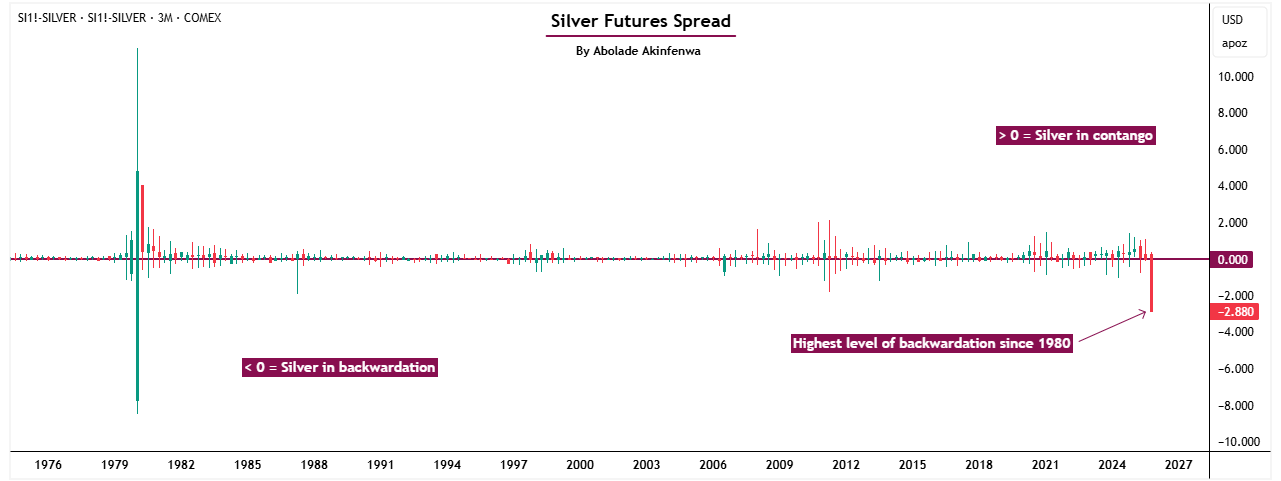
Across both London and New York, traders are reporting the same problem: silver for immediate delivery is hard to find. This doesn’t mean the world is running out of silver. It simply means the metal isn’t where it needs to be, when it’s needed.
London, the hub of global silver clearing, is feeling the squeeze the most. Bars that meet LBMA delivery standards are becoming scarce, while metal stored on COMEX or in Asian warehouses can’t move fast enough to relieve the pressure. The global logistics network has fallen out of sync with physical demand, and the market is responding exactly as you’d expect. Buyers are paying steep premiums to get silver they can take delivery of today.
But this story isn’t just about logistics. Something much bigger is happening beneath the surface. What’s really changing is how silver’s price is being set. For decades, silver’s spot price was largely controlled by futures trading on COMEX, a paper-based system dominated by speculative short sellers and algorithmic funds. That structure allowed “paper silver” positions to steer price action, often suppressing rallies even when physical demand was strong.
That setup, however, is beginning to break down. When backwardation becomes this extreme, it’s the market’s way of saying: physical demand has taken control. Real buyers and industrial users are now setting the tone, not leveraged traders. Each dollar of backwardation marks a shift in power away from paper markets and back toward the physical market, where actual supply and demand determine value.
We can already see this shift reflected in the charts. Between September 30 and October 10, the 4-hour chart reveals a clear pattern: futures are selling into strength while spot prices continue to rise. That’s not how a futures-led market behaves. It’s proof that spot is now leading and futures are being forced to follow.
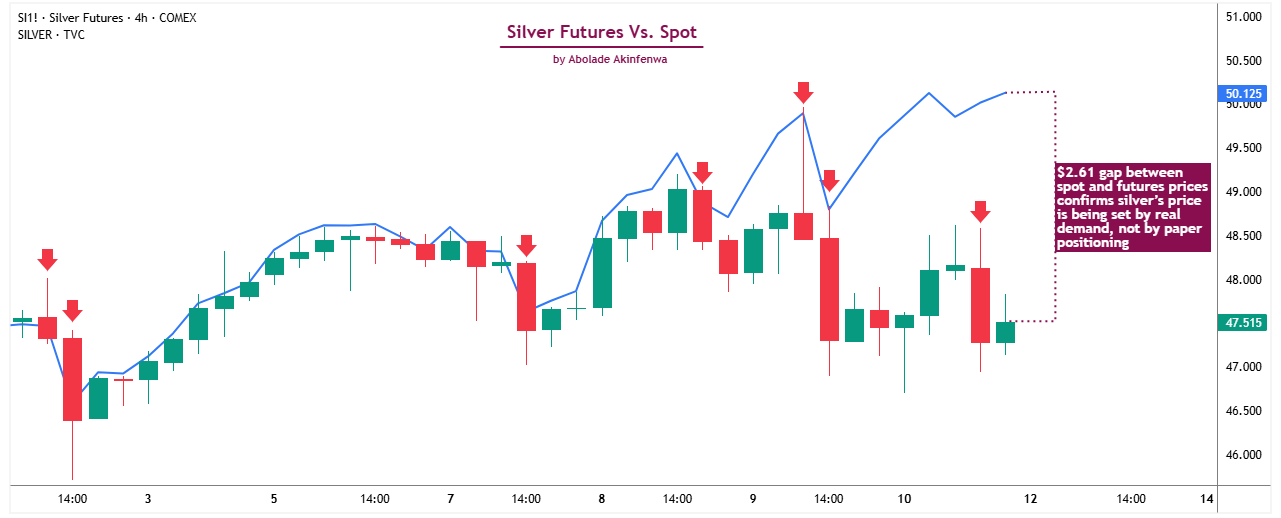
In my view, this marks a pivotal moment for silver. It signals the end of an era where paper markets could control spot prices through leverage and speculation. Silver is once again responding to the only force that truly matters: real-world supply and demand. And as price discovery shifts back to the physical market, the stage is being set for silver to finally break free from decades of suppression and reprice sharply higher.
What Persistent Backwardation Means for Silver
The silver futures curve now tells a striking story. Every contract through late 2026 is trading below the current spot price. That tells us this current backwardation isn’t just a short-term quirk. It’s stretched across the entire curve, which means the market expects physical scarcity to last for years, not months.
This isn’t a problem that a few shipments or inventory shifts can solve. The imbalance runs much deeper than that. Supply, demand, and logistics have completely drifted out of sync, disrupting how the market normally operates. And that breakdown carries major implications for how silver trades from here.
First, persistent backwardation confirms that the physical market is now leading price discovery. Normally, when the market is in contango, futures set the tone while spot prices follow along. But backwardation flips that dynamic. Spot becomes the anchor, and futures are forced to rise as each contract nears expiry.
That’s important because it means silver’s price is now being shaped by real demand and real scarcity, not paper speculation. Once the physical market takes control, prices start reflecting actual fundamentals. And when that happens, it becomes much harder for leveraged futures traders to suppress the price.
Second, persistent backwardation turns short positions into rocket fuel for silver’s rally. As borrowing costs (i.e., lease rates) surge, holding short positions becomes painfully expensive. Traders betting against silver are being squeezed from both sides: they can’t easily find metal to borrow, and they can’t afford to keep those trades open.
Eventually, they’re forced to close out their shorts by buying back futures or purchasing physical metal, both of which drive prices even higher. This creates a self-reinforcing loop. Tight supply lifts spot prices. Higher lease rates squeeze shorts. Short covering tightens supply even more. And the process keeps repeating.
Finally, all of these point to something even bigger: a revaluation of silver’s true worth. Persistent backwardation challenges long-held assumptions about what silver should be worth. It’s the market’s way of admitting that the metal has been undervalued for years relative to its scarcity and strategic importance.
As more investors recognize this shift, silver starts behaving less like a basic industrial metal and more like a monetary asset that reflects real-world supply and demand dynamics, not paper leverage.
The way I see it, the longer and deeper this backwardation lasts, the stronger the case becomes for a full-scale revaluation of silver in the years ahead.
What Silver’s Past Backwardations Teach Investors Today
History has a way of repeating itself, especially in the silver market. When silver goes into deep backwardation, it almost always marks a major bullish turning point.
The last time backwardation exceeded $2 was in January 1980, and what followed was nothing short of explosive. Silver gapped up by about 32%, jumping from $28 to $37.75. It then kept climbing to $48, posting a 71% rally in just one month.
That move was partly driven by the Hunt brothers, who aggressively bought both physical silver and futures. But the bigger story ran deeper. Physical supply dried up, paper shorts lost control, and the market suddenly realized futures contracts couldn’t deliver metal that didn’t exist. Once that reality sank in, prices repriced higher rapidly and forcefully.
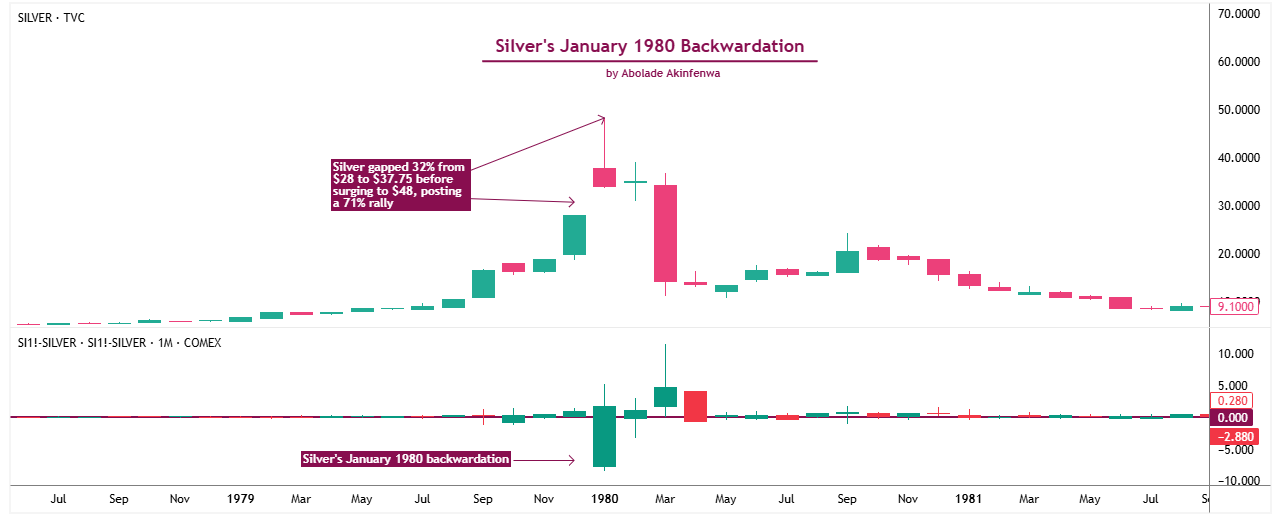
A similar episode unfolded three decades later in early 2011. Between February and April, silver’s futures curve briefly flipped into backwardation again. This time, heavy ETF inflows and surging investor demand for hard assets pushed the market to the brink.
It was the same setup, just a different era. Physical demand tightened supply right as investors piled into silver, looking for protection from inflation and currency debasement. The result was dramatic. The metal surged higher from around $28 in February to $49 by April, nearly doubling in just three months.
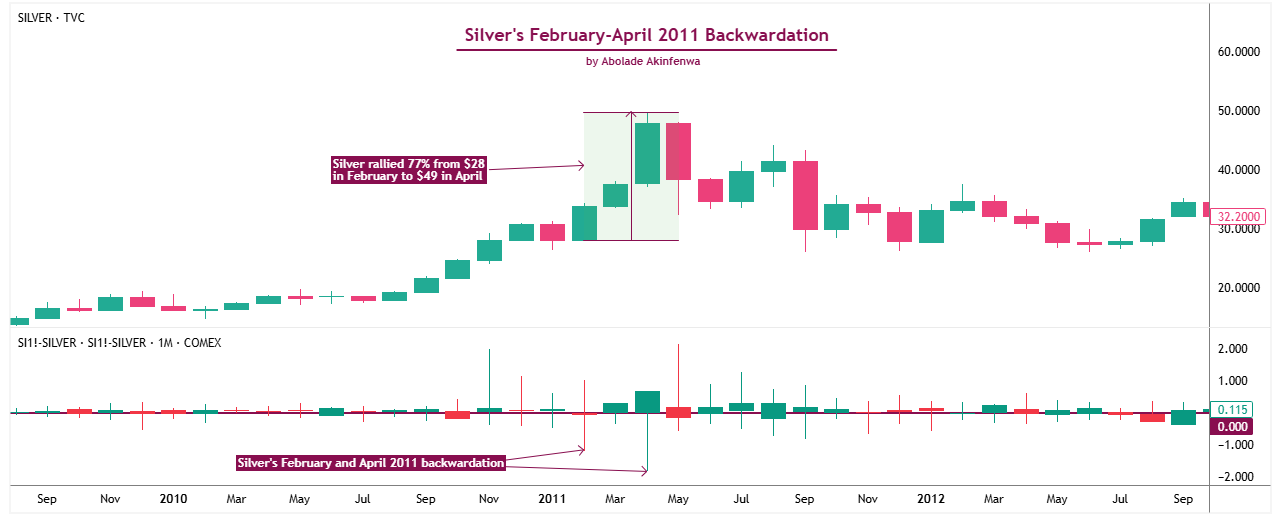
These two moments share a clear pattern. Backwardation wasn’t the cause of the rally; it was the symptom. Each time, the market hit the limits of its paper structure. Futures traders could no longer control the narrative once physical scarcity took hold, and prices were forced to catch up with reality.
Today’s setup looks eerily familiar, but the drivers are far more powerful and far more sustainable. In 1980, it was speculative buying. In 2011, it was investor excitement. This time, however, it’s steady industrial demand, strong investment inflows, and tightening mine supply.
Sure, the 1980 surge faded, and the 2011 rally fizzled. But the key lesson isn’t how those rallies ended; it’s what started them. Every time silver’s futures curve inverts this steeply, it signals that the paper market has hit its breaking point and that a major revaluation is already in motion.
The Case for Triple-Digit Silver
If silver is truly shifting from a paper-led market to one driven by physical demand, a major re-rating seems inevitable. For decades, traders have fixated on the old nominal high of $48 set in January 1980, treating it like a ceiling. But that number doesn’t tell the full story.
Adjusted for inflation using August 2025 data, that same $48 high equals about $199 per ounce today. In other words, silver hasn’t made a real new high in over forty years. To simply match its inflation-adjusted level, the metal would need to quadruple from its current price near $50.
From a technical standpoint, the chart supports that kind of move. Silver has spent decades forming a massive cup-and-handle base, which is one of the most powerful continuation patterns in technical analysis. On a logarithmic scale, the measured target for that formation points toward roughly $400 per ounce.
What’s fascinating is that the same number appears again when projecting silver’s long-term trend extensions across past cyclical highs. When two completely different methods point to the same price zone, that’s something worth paying attention to. And now that silver has finally broken through the 45-year resistance zone between $36 and $49 that capped every rally since 1980, the door to a new price regime is wide open.
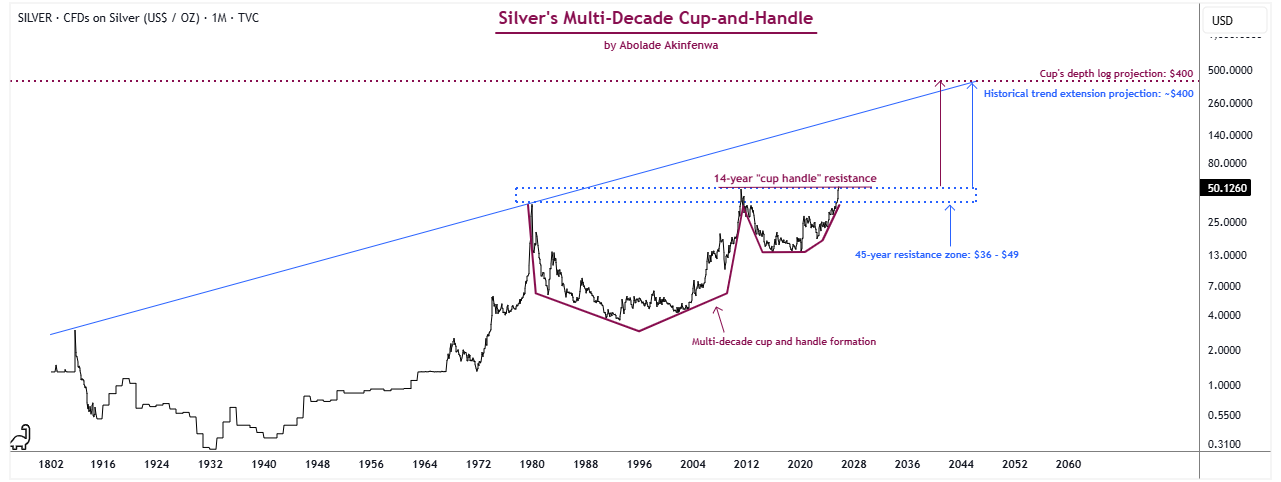
In a world where spot leads futures, inventories stay tight, and industrial demand can’t easily slow down, a range between $100 and $200 per ounce is reasonable. The $400 zone, meanwhile, represents what I’d call the “mania phase,” a full-blown trend extension driven by momentum and scarcity.
Could silver overshoot those targets? Absolutely. Commodities often do when they re-rate after long periods of suppression. The journey won’t be smooth (it never is with silver), but if real supply and demand continue driving prices, a move into triple digits looks far more like a catch-up to reality than an overestimation.
Ultimately, when a market breaks a multi-decade lid and physical demand takes control, it tends to seek a new equilibrium that reflects its true monetary value. For silver, that equilibrium sits north of $100, with plenty of room above if the structural squeeze continues. If you ask me, this isn’t wild speculation; it’s a long-overdue revaluation finally catching up with economic reality.
Final Thoughts
From where I stand, silver’s record backwardation feels like a wake-up call for the entire market. The old paper-driven system is losing its grip, and physical demand is finally stepping into the driver’s seat. That’s why I believe this moment matters more than most realize. If this dynamic holds, silver isn’t just heading higher; it’s redefining what “fair value” really means in a world that’s running short on trust and real metal.

